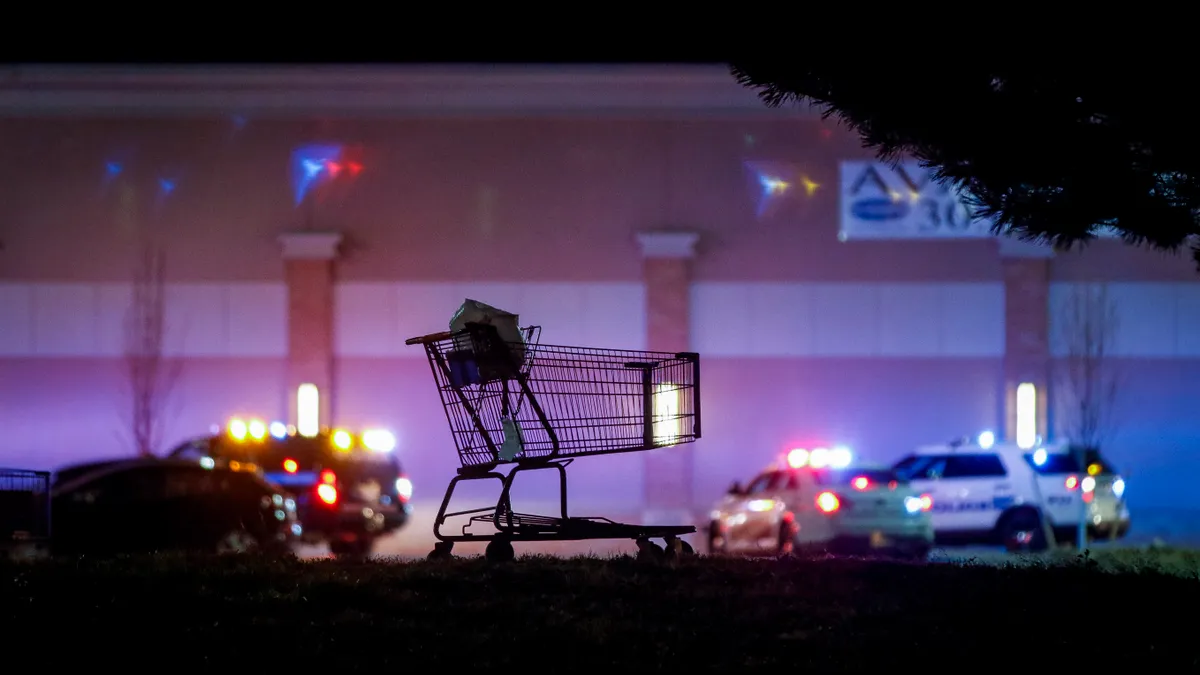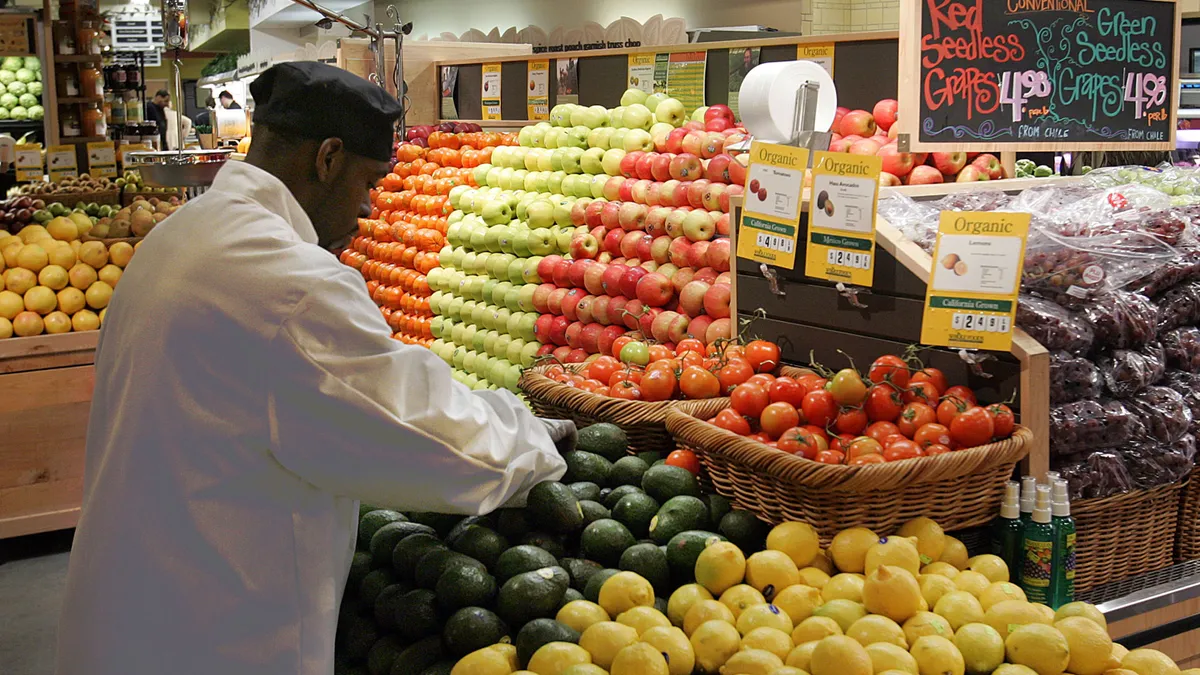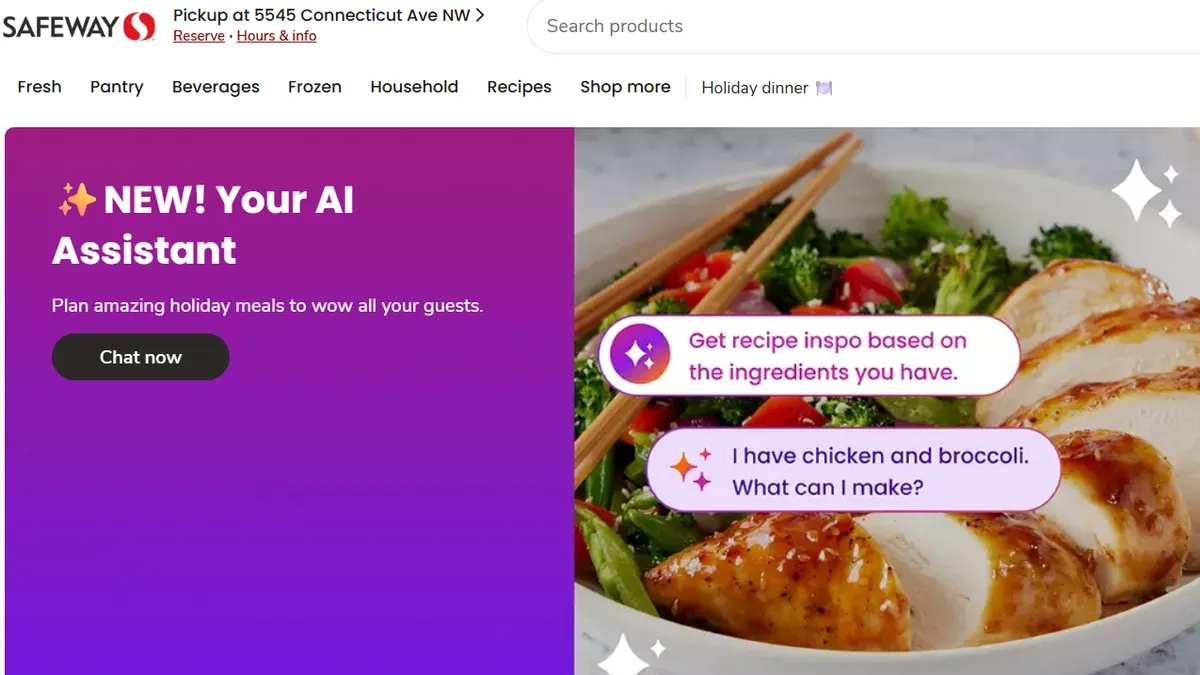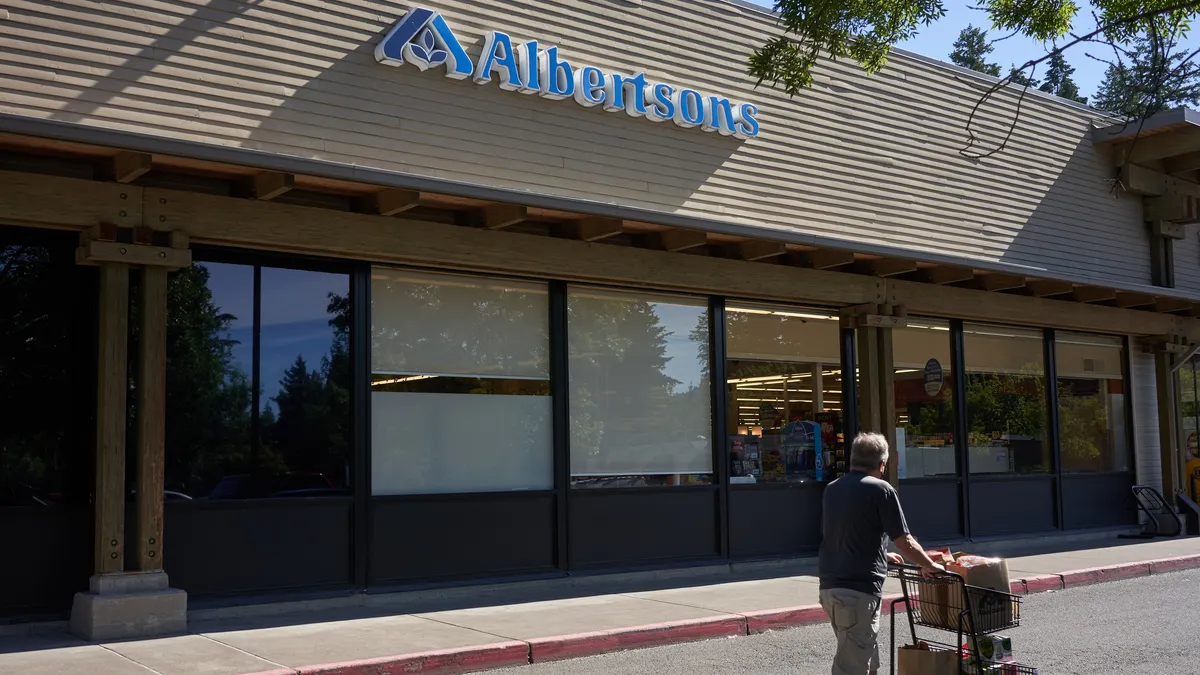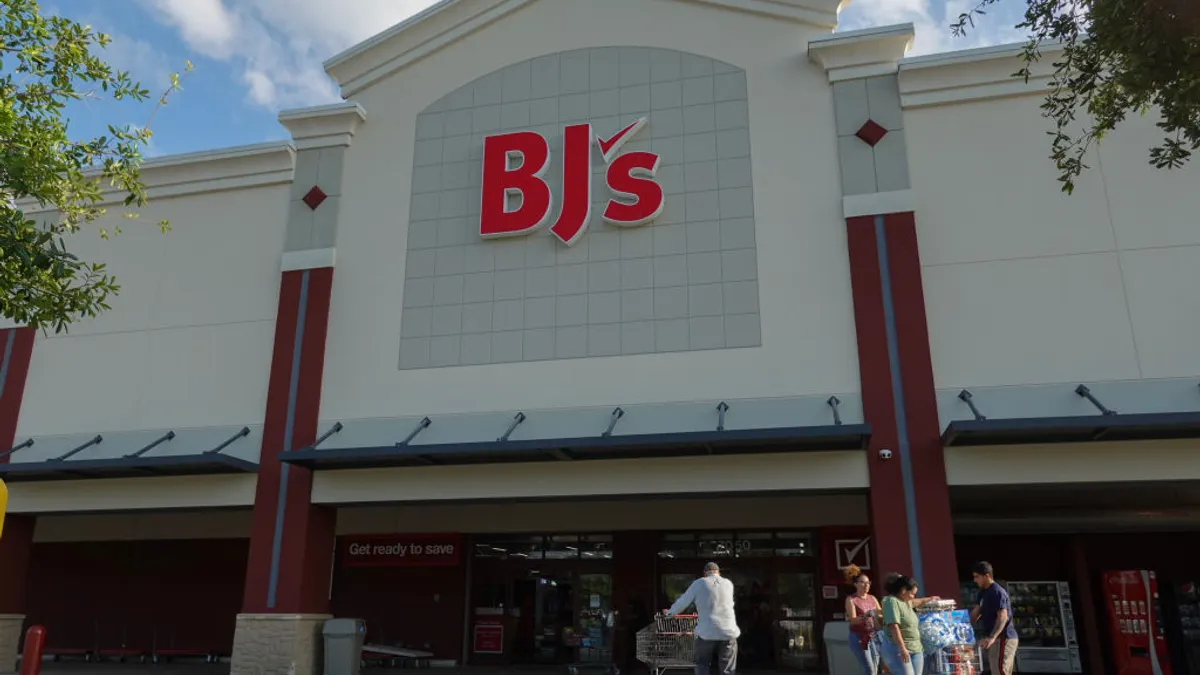The pandemic heightened the need to focus on the health and safety of customers and employees, but grocers face another grim issue putting lives at risk: store shootings.
On Monday, a shooter killed a cashier and injured two people at Big Bear Supermarket in Decatur, Georgia, after allegedly arguing with the cashier about the store's face mask policy. This follows violence at a Publix in Royal Palm Beach, Florida, last week where a shooter killed two people before killing himself. And in March, a gunman killed 10 people at a King Soopers in Boulder, Colorado.
Between 2000 and 2019, 69 people have been killed and 74 injured in 22 active shooter incidents on the premises of retailers selling groceries, per a Grocery Dive review of FBI data. 2019, the latest available year for the data, had the highest number of active shooter incidents (four), deaths (31) and injuries (29) during the 20-year period — largely due to the shooting at a Walmart in El Paso, Texas, that killed 23 people and wounded 22.
The continuing violence at grocery stores against the backdrop of the pandemic has heightened industry awareness of the need for safety measures and training, and has spurred the industry's main trade organization, the Food Industry Association (FMI), to provide additional guidance for member grocers.
Timothy Dimoff, CEO and president of Sacs Consulting and Investigative Services, which offers active shooter training and other safety consulting services, said his company has seen increasing interest from grocers in recent years in its training programs.
"We've been getting some requests from different types of grocery stores here lately because there just seems to be more aggression out there, but I will tell you the grocery stores, out of all the different types of businesses [we work with], are more on the bottom of the list, as far as requests," Dimoff said.
Active shooter events at food retailers
Industry groups offer resources, trainings
From food safety to natural disasters, grocers have long faced life-threatening issues to consumers and workers. But the pandemic placed a new emphasis on threats to employees and shoppers, and the King Soopers shooting in March, which created national headlines, made many consumers and industry workers more aware of the threat of gun violence on grocery store grounds.
One preventive measure that numerous grocers have implemented — active shooter training — focuses on preventing violence by identifying warning signs and behavior, as well as instructing employees on what to do if an incident occurs.
“It’s easier to implement a plan that you already know versus create a plan during an emergency scenario and then execute it,” said Leslie Bucher, business development director for Foodservice Training Portal, which teaches safety and compliance courses for food, hospitality and senior care industries.
FMI aims to offer online training videos with The Power of Preparedness (TPOP), which offers online courses on workplace violence and deescalation tactics. The contract between the two firms is in the final stages, Doug Baker, FMI's vice president of industry relations, wrote in an email. The goal is to have the training videos available to members by Aug. 1, Baker said.
In less than an hour, TPOP's violence and active shooter preparedness course goes over how to recognize workplace violence, behavioral indicators and different types of gunfire. It also teaches situational awareness, verbal deescalation techniques, response to injury and survival options, according to the company's website.
"FMI members will have the option of viewing the training [videos] through FMI or work directly with TPOP to customize to that member's preference," Baker said.
FMI also plans to hold a session on workplace violence on June 21, as part of its summer executive conference, which will be held virtually.
Baker said these resources are in keeping with FMI's mission to "make available tools, resources, and thought leadership to support our members [with] training and development goals. This includes making members aware of innovation in technology, training methods, and best practices to help mitigate the result of an active assailant."
The trade association's Active Shooter Guideline, published in 2018, includes Department of Homeland Security resources and goes over how grocers can prepare for, respond to, stabilize and recover from an incident. The guide also details behaviors that can be indicators of potential violence by an employee.
FMI also has committees on risk and safety, along with an asset protection community that acts as advisors, Baker said.
Other retail trade groups also offer education and training resources. The National Retail Federation has the Department of Homeland Security's Active Shooter Recovery Guide, which was published in 2017, available on its website, along with links to resources from the FBI and U.S. Secret Service. The National Grocers Association offers a course called "Active Shooter Awareness," which in 2020 was its third most popular course among the more than 175 it offers on its site.
Run, hide, fight
Active shooter training, which applies to other weapons in addition to firearms, usually covers options employees have, including running to the exits, hiding, locking down in a safe room and engaging with the assailant. “Run, hide, fight” are the common tactics taught during safety training, sources said, but the formats, customization options, duration and pricing vary.
Each program can cost between a few thousand dollars to $5,000, depending on the size of the store and number of employees, Dimoff said.
Sacs Consulting offers online and in-person training customized for each store, Dimoff said. The training can be done in approximately one hour, and Dimoff recommends it happens with a live instructor who can answer participants' questions.
Foodservice Training Portal launched its Active Shooter Prep in 2016. The on-demand, generalized online training usually lasts for 30 to 40 minutes, with an assessment at the end that attendees need to pass in order to receive a certificate, Bucher said, noting that clients are advised to localize the techniques taught to their stores. Access for 30 people for one year costs $299.
"It’s easier to implement a plan that you already know versus create a plan during an emergency scenario and then execute it."

Leslie Bucher
Business development director, Foodservice Training Portal
Training on how to defuse and deal with difficult people can pair well with active shooter training, Dimoff and Bucher said. Because grocers typically have high employee turnover rates, Bucher said having efficient and cost-effective training options is key.
FMI’s guideline recommends “frequent training opportunities utilizing your local police or sheriff.” Baker said that many of FMI's members offer corporate training virtually and in-person training for new and existing associates throughout the year.
Bucher recommends workers receive training as part of their onboarding process and as part of any ongoing training schedules. “It’s not a once-and-done scenario” because store layouts and employees’ roles can change, she said. Meanwhile, Dimoff said yearly training for all employees along with training for new hires within their first three to six months is sufficient.
The Giant Company requires each team member to complete active shooter training annually, a spokesperson wrote in an email. Target employs a "comprehensive approach" that includes team member training, partnerships with law enforcement, technology and ongoing reviews of its security measures, a spokesperson wrote in an email, declining to share specific details about its safety procedures.
The Independent Grocers Alliance (IGA) offers an "Active Shooter Awareness" course produced with the Department of Homeland Security and the Mayor of Houston's Office of Public Safety. Irene Cooper, project manager at Lake Region IGA in Hawley, Pennsylvania, said her store's employees take the training annually.
Aldi, Albertsons, Schnuck Markets, Grocery Outlet and Sprouts Farmers Market declined to comment on their security measures. Kroger and Walmart did not respond to requests for comment.
Additional safeguards
Along with training, features like security cameras, a security guard, weapon detection systems and signage about surveillance can also boost safety, Dimoff said.
"When they see cameras and you have signs that talk about the cameras and when you have police officers or security personnel there in uniform — and then the icing on the cake is training your employees to notice things — that’s a really good solution to deterring people from carrying out aggressive acts,” Dimoff said.
Sacs Consulting performs store safety audits and often finds a lack of signage and camera systems that are outdated.
“What we found ironic in grocery stores is customers are happy that they're under surveillance," Dimoff said. "They want to know they're safe. They don't look at it as an infringement.”
Grocers can also connect their intercom systems to their cameras and use code names or secret phrases to communicate. Cooper of Lake Region IGA said store employees are trained to use secret codes to communicate over the intercom if there's an emergency.
Bucher suggests employers have an anonymous communication channel for employees to report suspicious behavior by employees without fearing repercussions.
Bucher said active shooting training is often "overlooked but incredibly relevant" as the pandemic has placed greater emphasis on employee and shopper safety at grocery stores.
“We’ve taken a lateral step towards day-to-day safety because of the nature of the pandemic. … As we begin to re-emerge from that, I think employee safety has been a key concept that is going to continue to bear weight," Bucher said.


